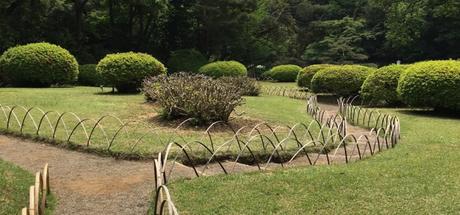
When you think of Tokyo, what comes to mind? For me, it was fresh sushi, sumo wrestlers and crowded streets. I, admittedly, didn't know that much about Tokyo before visiting the massive city-13.5 million in the city and over 37 million in the greater metro area. In my mind, I pictured busy-busy-busy, bustle-bustle-bustle.
Recently, I set off for Tokyo to visit my husband, who was working there on a three-month assignment.
Because he was in Japan for work, I would spend a good portion of my time exploring Tokyo on my own. I was a little nervous for that, considering I don't speak any Japanese and the city of Tokyo is huge. Since he had been there for two months prior, he was able to give me some pointers on what to visit and even put together my Japanese language survival guide with key phrases and words I should know.
My plan was typical to most vacations-eat, learn, sight see, repeat.
But before I could begin exploring, I had to get there-a long, potentially grueling, 13-hour flight.
Fasten your seatbelt (and take some Advil PM)
Flying to Japan is a chore. From the east coast of the U.S. you'll fly north, over Canada, Alaska and maybe the North Pole. Then, you'll hit Korea on your way to the Land of the Rising Sun.
To prepare for such a long flight takes some planning.
The night before the flight, I made the rookie decision to attend a concert. I was completely packed and ready to go, but I knew that post-concert adrenaline and pre-flight anxiety might prevent me from sleeping. Rather than try to get some serious Zzz's, I decided to stay up almost all night to make sleeping on the flight easier.
Though the trip from the east coast (Newark, New Jersey, to be exact) is 13 hours, you spend the entire flight chasing the sun around the globe. This sounds cool, but that also means it never gets dark. Most passengers on the flight will keep their shades down, and the flight crew will turn the lights off to help people sleep. But if you're sensitive to light, you might want to travel with an eye mask.
I didn't take an eye mask, but dressed in layers and used a scarf to cover my eyes at times. Slip-on sneakers also made it easy to get comfortable and stay warm on the flight. The cabin was cool, and the outside temperature was a freezing negative 70 degrees at our cruising altitude of 38,000 ft.
Prior to the flight I focused on hydration. Humidity in the flight cabin thanks to air recirculation and cabin pressure is much lower than a normal environment on the ground. So it's important to make sure you drink lots of water. This will also help with some swelling you experience from being at high altitudes. I forced myself to drink two liters of water while I waited at the gate, and took another liter of water on the flight with me.
To make the time go by and decrease the chances of jet lag, I also took Advil PM. I left at 11am EST and landed at 2pm JST the following day; my goal was to stay awake through the day once I got there, which would only happen if I could sleep on the plane.
When I woke up a few times during the flight, I took some time to stretch out-squats in the bathroom and quad stretches and calf raises in the aisle. Making sure you're hydrated and you keep blood flowing will reduce any muscle soreness and make your transition to your new destination much easier.
Thirteen hours and 7,000 miles later, we touched down in Tokyo.
Tokyo is incredibly walkable
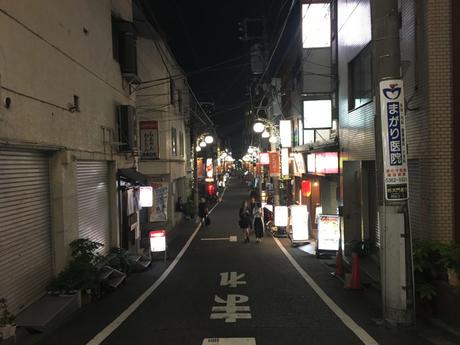
Wide thoroughfares might seem similar to those in other major cities, but Tokyo's side streets wind up, down and around sharp corners without a sidewalk in sight. And the businesses are stacked vertically and horizontally, which means there are doors upon doors upon doors. It also means that if you're searching for a particular business, you might need to look up. Storefronts aren't always at ground-level, which can make visiting some restaurants and stores feel a little intimidating.
All of this, combined with a confusing address system can make navigating Tokyo difficult.
Since I'd be exploring most of Tokyo on my own, I rented a personal WiFi device so I could translate signs, view Google Maps and look up train times. It also gave me a way to connect with anyone if I did actually get lost or have a question. Personal WiFi devices can be rented from a number of companies and run around $5-7/day, depending on the device model and internet speed.
Despite the challenges, Tokyo is incredibly walkable. It's very clean, quiet, and the people are respectful and helpful.
Most vacations involve a good deal of walking, but I had no idea just how much walking I'd do in Tokyo.
My first full day in the city, we walked about 15 miles total, from Roppongi, where my husband was staying, to the National Diet Building and Tokyo Imperial Palace, through Hibiya Park, to Ginza's business district, near a large shopping area, and back through Akasaka to Hie Shrine and back to Roppongi. Phew - what a workout!
But the long trek was completely worth it to see some of the narrow streets of Tokyo, filled with multi-floor shops and restaurants that you'd never see otherwise. You can get a feel for how quiet the city actually is, and how calm and respectful its citizens are. Pedestrians move through the city quickly and quietly, not crossing a street a moment too soon.
But if you need to get from one area of Tokyo to another that's a few miles away, you might want to save time and energy by using its massive transportation system. Tokyo has the most expansive urban rail network in the world, with 158 total subway and rail lines stretching across the city. Over 2,000 subway stops make it easy to get from one ward of Tokyo to another, even if you don't speak Japanese.
While I didn't walk 15 miles in a day for the rest of the trip, I did average six to eight miles plus any train or subway travel time, which meant I didn't have time for most of my regular workouts during the trip. At the end of each day I was exhausted from just walking around; the last thing I felt like doing was running four or five miles.
The food is less processed and meals are more balanced
My first full day, we stopped at Hibiya Park to try takoyaki, flavored batter with octopus inside, topped with Japanese mayonnaise, takoyaki sauce (a tangy barbeque sauce) and bonito flakes. Not the healthiest of treats, but walking all day warranted a few treats. On the whole, the Japanese diet is much healthier than an American diet.
A healthier snack we enjoyed frequently were onigiri rice balls, which can be found at just about any small convenience store, or combini, which dot Tokyo streets. You can find white or brown sticky rice balls covered in seaweed and stuffed with hard-boiled eggs, chicken, fish and a number of other fillings. These snacks were just over $1 and were great for a quick breakfast or a midday pick-me-up.
You'll find that, in general, combini are great places to find healthy snacks. The Japanese have very high standards when it comes to food preparation and cleanliness; you'd never question whether or not what you're buying at Lawsons or Family Mart is high quality. Besides rice balls, you can also find bento boxes, hard boiled eggs, sandwiches, and numerous hot and cold drinks. They definitely beat any convenience stores we have in the states.
Of course, one of the main draws for many to Tokyo and Japan, in general, is sushi and sashimi. You can find sushi and sashimi on every street in
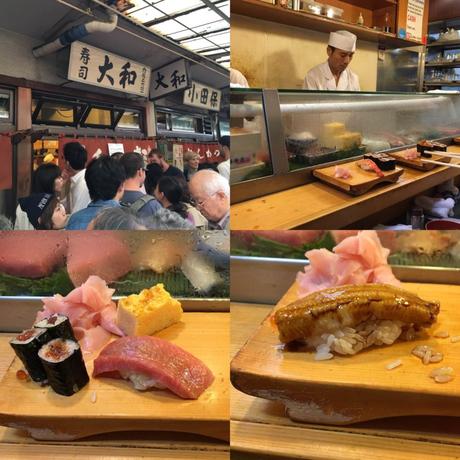
While it's difficult to get a spot for the world-famous tuna auction (you likely have to camp out overnight for one of only 120 spots and the auction itself starts at 5am) you can visit the market in the morning or early afternoon to sample just about any type of fish, fruit or vegetable-and a number of different types of Japanese cuisine.
I planned to walk around the market to see some of the more exotic foods, but first I was on a mission for sushi at a super popular restaurant called Daiwa Sushi. I arrived hungry around 10:30 am, preparing to wait up to two hours for a coveted spot at the sushi counter. The restaurant is divided into two narrow parlors with about 12 seats at each. There's barely enough room to walk between the stools and the wall, especially if you are carrying a bag or backpack.
Outside the restaurant a line of anxious diners snaked back and forth. There were about 50 people in front of me, and an usher told me the wait might be about 70 minutes. But I got lucky-every time a single spot at the counter opened up, a party of one would get plucked from the line, making my total wait time just over 30 minutes.
I took a seat at the sushi bar and was given miso soup-a staple of many Japanese meals-and tea. Then I watched the chef in action. Each piece of nigiri was cut from fish that was likely caught that morning, placed atop sticky rice and a bit of wasabi and, unlike nigari in the states, was brushed with soy sauce. Fatty tuna was melt-in-your-mouth good, but eel, squid and Hamachi were also delicious. Everything tasted so fresh. In addition, the meal included uni, tomago-a block of cold, sweet scrambled eggs-tuna and a salmon roe roll and tuna roll for 3,500 yen (just under $35). It might seem like a lot for lunch, but it was easily the best sushi meal I've ever eaten.
If a $35 lunch is too much to stomach, you can easily find fresh sushi, ramen and other lunch options for under $10. During my visit to Yoyogi Park and Harajuku's Takeshita Street I found Harajuku Gyozaro, a tiny restaurant off a small, crowded side street. For under $10, I got six gyoza, crunchy cucumbers with miso sauce (which I now crave) and a Sapporo (which I had also earned from walking so much).
As I mentioned, the Japanese diet is much healthier than the diet in the United States. Part of that is because portion sizes are smaller-making any trip to Japan likely more healthy than a trip to many other countries. The foundation of the Japanese diet is rice, fish and vegetables; Japanese people naturally eat far fewer processed foods than we do in the U.S. That's not to say they and other treats don't exist-in fact, it seems you can find a French or Italian bakery on every street. But even the bakeries, gourmet pizza shops and French restaurants are not a focus of the Japanese diet.
Sightseeing often doubles as a workout
Since this was my first visit to Tokyo, I wanted to cover a lot of ground. I had the opportunity to visit a number of shrines and temples around the city and see just how big Tokyo is from the Tokyo Skytree, Tokyo Tower, Mori Tower and the Park Hyatt Hotel.
But the parks in Tokyo can make it feel like you're miles from the city, not surrounded by 13.5 million people. Yoyogi Park and Meiji Shrine were particularly peaceful, with tall trees that create a thick canopy above. The Meiji Jingu Inner Garden felt even more removed from city life with small ponds, a tea house and several forest trails.
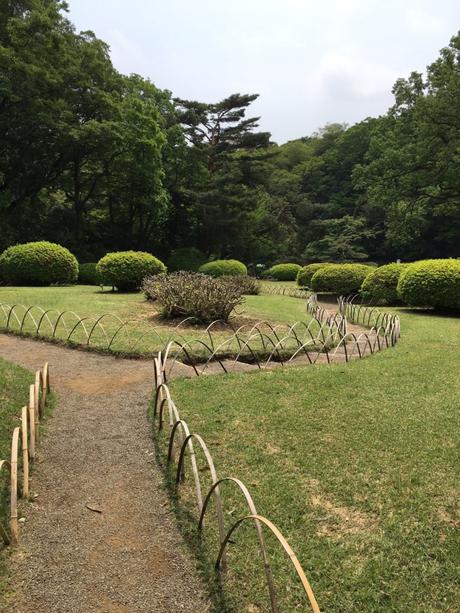
Shinjuku Gyoen National Garden, another major park in Tokyo, is filled with open areas to picnic, as well as beautiful gardens featuring flowers from around the world.
But it was a day trip to Mt. Takao that provided a greater workout than I planned for, beautiful views, and a lot of peace.
On a cool Monday morning I hopped on the Keio Line train to Hachioji, about an hour outside the city center, but still within Tokyo Prefecture.
Mt. Takao is a popular day trip destination with a network of trails, a cable car and lift that leads to a 599-meter (about 2,000 feet) summit.
The trails vary by distance and difficulty; given that the forecast called for rain, I decided to take Trail 1, a paved route that seemed like it would offer excellent views and some interesting sights along the way.
What I was surprised about was just how steep the trail was, and how much of a challenge it presented.
I'm not an avid hiker, but I am a runner. Outfitted in my running shoes, some running tights and a few layers of clothing, I started scaling the mountain. About a quarter-mile into my ascent, the trail began doubling back and it seemed to get steeper and steeper each time. The small water bottle I brought along was almost empty; I was winded and sweating. This hike was much harder than I thought it would be.
Along the first part of my hike were prayer wheels and small statues to admire. I gladly stopped to look at each one just to catch my breath. The third time the trail doubled back, a group of elderly men wearing suits and clearly not fazed by the steep incline passed me. That was kind of aggravating. Or inspiring.
But soon the trail seemed to even out to a more gradual ascent-the paved road seemed manageable, and far more enjoyable.
At a rest stop near the cable car station, I stopped to buy more water and fuel the rest of my hike-I had most certainly burned off the calories from my breakfast bar. I opted for dangos-warm, squishy mochi covered in a sweet soy sauce, which made for a satisfying treat that gave me enough energy to get to the top.
The second half of my journey was much easier than the first, and along the way were foggy views of the valley surrounding Takao, massive cedar trees, a Relics Stupa, and finally Yakuo-in Buddhist Temple.
After visiting the temple, the ascent continues up several stone staircases and some more paved trail. By this point it was raining lightly and many other visitors had turned around to head back down the mountain, which actually made for a peaceful finish to my climb.
The top of Mt. Takao didn't offer the best views because of the rain and fog, but it did bring a sense of accomplishment.
Though my initial pla
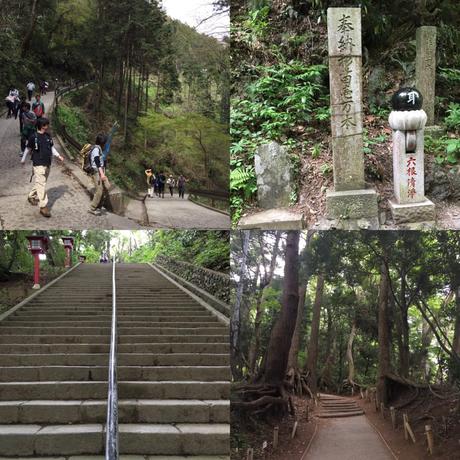
Just like many other aspects of my trip to Tokyo, the day trip to Mt. Takao was more challenging and exciting than I thought it'd be-and it made for a great workout during my surprisingly healthy vacation.
The combination of walking several miles each day, eating small, healthier meals and snacks, and occasionally treating myself to a light beer (like most Japanese beers) or glass of wine made for a trip that was pretty healthy - even though that wasn't really something I was planning on.
I left Tokyo feeling like I did a great job of staying fit during my trip, unlike most vacations where you might gain a few pounds. I didn't lose any weight, but I did feel good when I left. For my husband, staying in Tokyo for three months meant changing his diet, eating more like the Japanese, and exploring the city on weekends. When he returned to the U.S. he had lost about 15 pounds!
If you're thinking of visiting Tokyo, I say go. It's a great destination - wonderful people, fantastic food, and sightseeing that seems like it's out of a movie.
And you might even come back in better shape than when you left.

